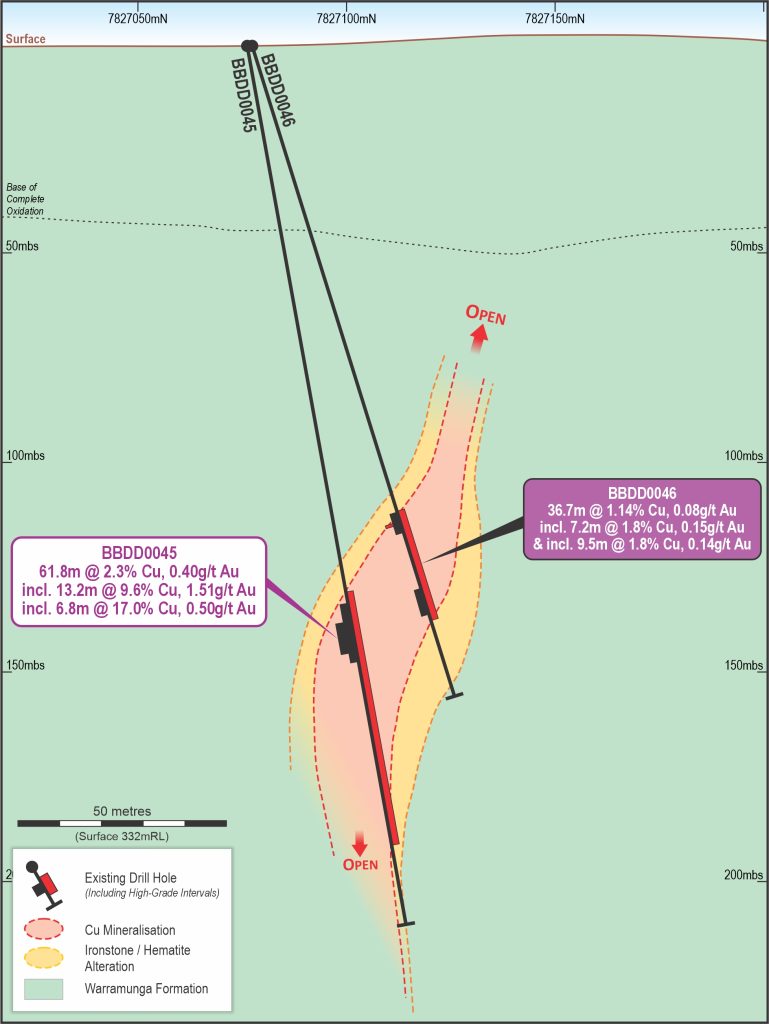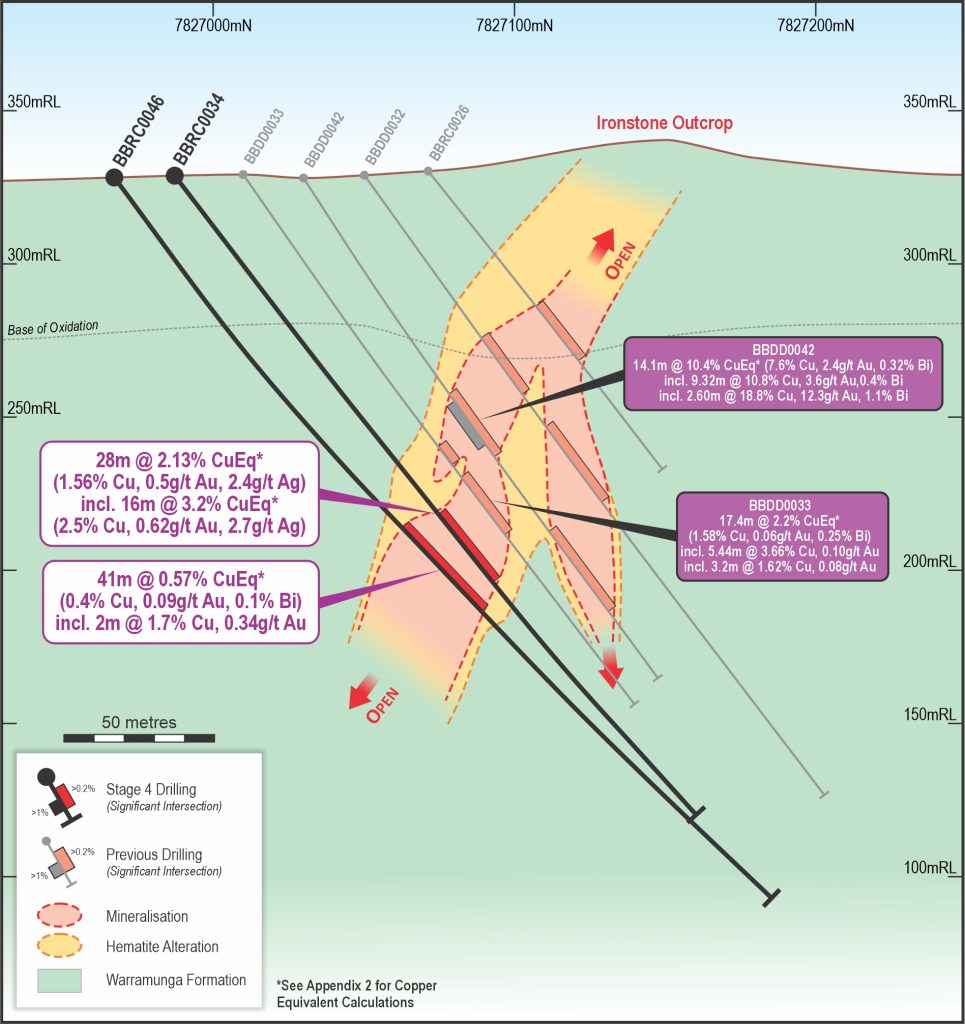Barkly Project, Northern Territory (TMS 100%)
The current focus of the Company is the Barkly Project, located approximately 45km east of the town of Tennant Creek in the Northern Territory, and comprising two granted Exploration Licences, being EL 28620 (Barkly Project) and EL 30701 (Babbler Project).
The Barkly Project is highly prospective for high-grade copper-gold deposits, being located on the eastern edge of the richly-endowed Tennant Creek Mineral Field, which has produced over 5.5Moz of gold and over 700kt of copper from 1934 to 2005 (see Figure 1 below).

Figure 1: Location of the Barkly Project and historical mines in the Tennant Creek Mineral Field
BLUEBIRD DISCOVERY
The Barkly Project includes the Company’s greenfields Bluebird high-grade copper gold discovery. Bluebird is one of multiple copper-gold targets within a 5km gravity-defined corridor within the Company’s 100% owned Barkly Project (see Figure 2 below).
The mineralisation intersected at Bluebird is typical of the major high-grade copper-gold orebodies previously mined in the Tennant Creek Mineral Field. The high-grade mineralisation is associated with intense hematite alteration and brecciation with malachite (copper-carbonate), native copper and visible free-gold in the upper parts, which transitions to primary sulphide mineralisation at depth including chalcocite, bornite and zones of massive chalcopyrite.
Drilling to date at Bluebird has identified copper-gold mineralisation over an 800m strike length and now to over 400m depth. The mineralisation is associated with intense hematite alteration and brecciation with malachite, native copper and visible gold in the upper parts of the zone, which transitions to primary sulphide mineralisation including chalcocite, bornite and chalcopyrite.
The Company has adopted a dual strategic approach of defining the Mineral Resource potential of the Bluebird discovery whilst also testing other key targets in the 5km Bluebird gravity corridor (Figure 2).

Figure 2: Barkly Project, 5km Bluebird gravity corridor and key copper-gold target zones

Figure 3: Bluebird plan projection showing 3D gravity model and current and planned drilling
Diamond Drilling, comprising a total of 31 holes for 7,051.5m was completed in December 2023. A Reverse Circulation drilling (RC) program comprising 22 holes for 6,241m commenced was completed in July 2024, with results released after the end of the Period (included in this report). The drilling programs at Bluebird during the Period successfully expanded the Bluebird discovery to more than 300m below surface and extended the high-grade copper-gold zone to both the east and west. New interpretations of the mineralisation at Bluebird show four large discrete high-grade copper-gold mineralised lenses (150-300m in length and 100-200m in depth), occurring within the east-west trending ironstone host corridor that extends across the entire 2.5km strike-length Bluebird-Perseverance corridor (Figure 3 to 6). Mineralisation remains open to the East and West.

Figure 4: Longitudinal view of Bluebird Cu-Au mineralisation 3-D models with significant intersections extending the zone to the east, west and down-plunge

Figure 5: Bluebird cross section 448,300mE showing new high-grade copper intersection in BBDD045

Figure 6: Cross section 448,500mE, showing thick hanging-wall copper-gold zone, open at depth
PLANNED ACTIVITIES
Following the ongoing success of drilling at Bluebird, The Company will continue to expand its exploration of the Licences at the company’s 100% owned Barkly Project.
Further drilling planned in 2024 will aim to extend the main Bluebird discovery as well as define potential connections with the Bluebird East and Bluebird West exploration targets (Figure 3). A new interpretation of the drilling at Bluebird shows it is made up of four, large, high-grade copper/gold mineralised lenses within the east-west trending ironstone-host (Figure 4). The interpretation of multiple lenses being present at Bluebird opens up the potential for further extensions to the east and west and down plunge of the Bluebird discovery. New targets have been identified within the ironstone gravity corridor which extend up to 5km to the tenement boundaries. These are coincident magnetic and gravity anomalies and are the targets for follow up exploration. (Figure 2)
Further exploration will test a range of targets east and west of Bluebird, including Perseverance, 2km west of Bluebird, as part of an NT government co-funded exploration grant.
New geophysical data collection and interpretation will precede new drilling planned on the Babbler tenement, EL 30701 (Figure 1), to test drilling targets within the interpreted underlying Warramunga Formation for high-grade copper-gold deposits. Babbler offers an exciting new discovery opportunity for Tennant Minerals.
Excellent results were achieved from metallurgical test-work to date which is highly encouraging for the development of a simple and straightforward processing pathway to deliver economic copper and gold concentrates from any future operation at Bluebird. The ultimate purpose of this initial phase of metallurgical test-work on the Bluebird bulk samples was to understand the extractive behaviour of the copper and gold in the mineralisation and use this information to develop a preliminary processing circuit design for the identified mineralisation.
More work will be carried out in the following areas to improve our understanding of the metallurgical behaviour of the Bluebird mineralisation:
- Optimising the recovery of gold in gravity concentrates previously reported to the ASX. Given current high gold prices, this work is very important for the project.
- Test-work to date has been completed on both fresh and partly oxidised copper sulphides. Identification of other mineralisation types requires further test-work on different material types to ensure all materials that may report to a future plant are understood and accounted for in testing for optimised/maximised extraction and sales
- Develop a pathway for the recovery of Critical Minerals known to be present at Bluebird including Cobalt and Bismuth.
This would enable the Company to establish a maiden Mineral Resource estimate at Bluebird and, with the benefit of the new metallurgical information, commence development studies and permitting for a new high-grade copper-gold project at a critical time of growing demand for copper (and gold) globally.
METALLURGICAL TESTWORK
The mineralisation at Bluebird is associated with intense hematite alteration and brecciation with malachite, native copper and visible gold in the upper parts of the zone, which transition to primary sulphide mineralisation including chalcocite, bornite and chalcopyrite.
After the completion of cleaner stage flotation testing of mineralised samples, the Company’s metallurgical consultant, Strategic Metallurgy, indicated that a potentially commercial process plant using Bluebird materials could produce a copper concentrate of 24-29% Cu with a copper recovery of over 90% from all materials, using similar flotation conditions. Gold reports with the copper concentrate at average grades between 1.5 g/t Au to 4 g/t Au, recovering between 58% and 79% of Au. The balance of the gold reports to flotation tails, which are the subject of on-going gravity and cyanidation test-work.
A single set of optimal conditions has now been determined for the treatment of fresh, transitional and very high-grade materials with no degradation in flotation performance. This will enable the Company to develop an efficient extraction process for the Bluebird copper and gold mineralisation, in addition to other critical elements such as bismuth and cobalt, while also providing a solid foundation for an economically viable model for the project.
Previous mining and processing operations within the Tennant Creek Mineral Field, such as at the Peko mine, treated flotation tailings, with gravity and cyanidation leaching, to successfully extract remnant gold from the tailings after copper extraction. The presence of gold in the tails at Peko (up to ~30%) is consistent with the results to date from Bluebird, and the Company is doing further work to develop this part of the processing circuit to substantially increase gold recovery.

Figure 7: Cleaner Flotation Concentration of Chalcopyrite from BBDD0045, Bluebird Copper-Gold Discovery
